Gets it's name because it looks like the old fashioned barbers cut throat razors.
The common or pod razorfish is the larger of the two growing up to at least 12" long and has a straight shaped shell.
The smaller sword razorfish is named after the curved cutlasses used by pirates, it's shell turning inwards slightly at each end. It grows to about 6" long.
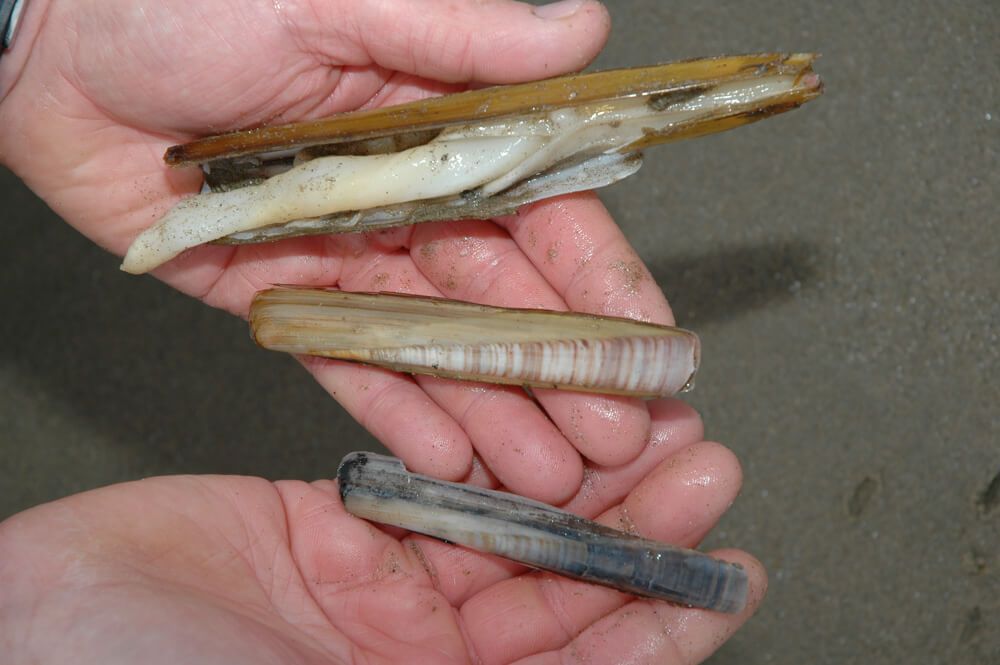
HABITAT
Lives along the mean low water line of big spring tides on clean sandy surf beaches. Colonizes sandy gutters in small concentrations, or in vast beds spread along the flat sands. Divers report that large razor beds can extend far out to sea and in water depths up to at least 100.
Prefers areas of tightly packed sand which is easier to form a permanent burrow in than loose, coarse grained sand that is continually moving.
Can be found to a lesser degree inside estuary mouths, again on sand banks and sometimes in a mud/sand mix just to the edge of the main estuary channels where the tide run is lessened.
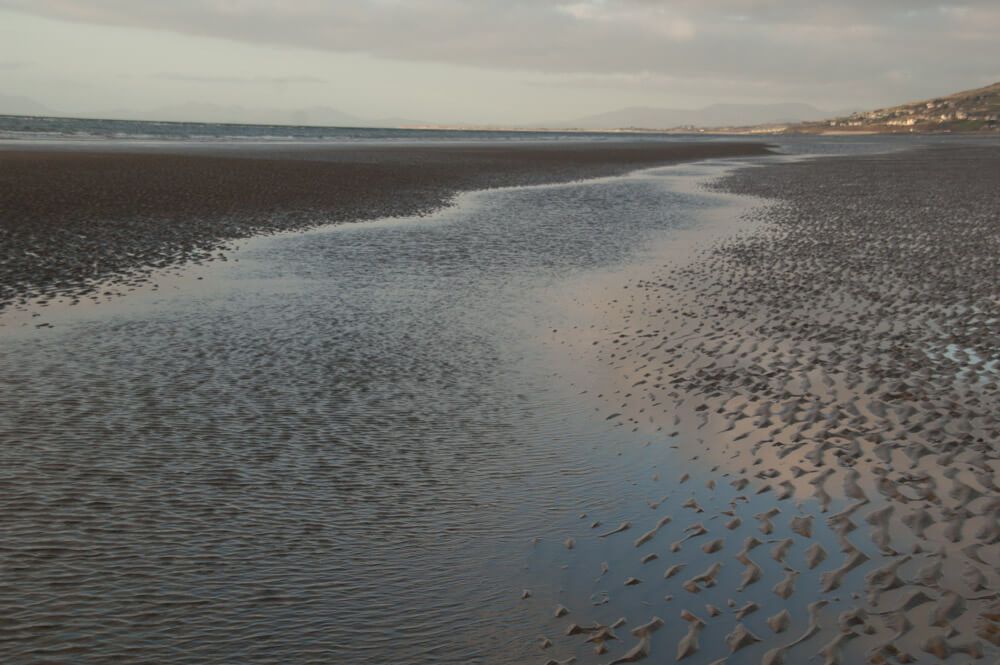
SEASON
Being sand burrowers and making a permanent home on the beach razors are collectable over the full 12 months of the year.
TIDES
These are critical for collecting razorfish. Only on the very biggest spring tides of the monthly cycle will large expanses of the razor beds be uncovered and provide maximum collection time.
On the smaller sized spring tides only the very fringe of the beds is exposed, giving only a limited time to collect the razors.
Ideal tides to pick are the springs that fall during a period of high pressure when the predicted low tide level can be exceeded and the tide travels further out than expected.
During periods of unsettled seas with a long surf wash running up and then backwards down the beach, often the tide does not go out as far as predicted making collection difficult.
WEATHER
Razorfish are not tolerant of cold weather, so avoid trying to collect razors during frosty weather, especially if the sand where the razors live will be exposed whilst frost is forming. This pushes them much deeper into their burrows.
Razors will also be deep during rough seas. They are prone to being washed completely out of their holes through sand displacement, so burrow deeper just prior to storms which they predict by feeling the change in barometric pressure.
NO HEAVY FOOTFALLS
Razorfish are hunted by birds, so they've developed a warning system that detects pressure displaced by weight on the sands surface. If they feel sudden increases in pressure over the surrounding sand near to their burrow, they eject water through their syphon and dive deep like a submarine.
Whichever form of collection method you decide to use, the secret to success is to tread lightly and carefully, or the razorfish will be long gone and too deep to extract.
SPOTTING RAZORFISH
This is easy. Razors leave a tell tale key hole shaped opening at the top of their burrow. Sometimes though, this can fill in slightly if the sand is wet and looks more like a shallow dish in the sand.
The other way is to walk backwards along the sand, and as your weight is detected by the razor as you walk over it's hole, you'll see the water spout they eject as they burrow to escape.
COLLECTION
METHOD 1
The simplest way to collect a bucket of razorfish is by using saltwater. Clean out a washing up liquid bottle and fill it with seawater that's got 4 heaped desert spoons of rock salt added to it.
Search the sand looking for the open key hole depression, but treading lightly, then squirt a liberal amount of the salt solution down in to the hole. Move on and locate a few more holes within a small radius of the first pouring the salt water down in to each.
What happens now is that the razors either think the tide has come in and rise in their burrows to feed through their siphons, or they dislike the heavy concentration of salt and rise to try to clear it. Whichever, it makes them poke the tops of their shells above the sand, and providing you use light footsteps, you can approach the razor, but there is a special technique required to actually remove them whole from the burrow.
Grab the razor by the top of the shell, but don't try to yank it out, or you'll end up with an empty shell and the poor razorfish is left naked deep down inside the burrow where it will die. Keep a steady but gentle upward pressure and you'll feel the razor give a little then hold, give some more and hold, but eventually it will come clear and intact.
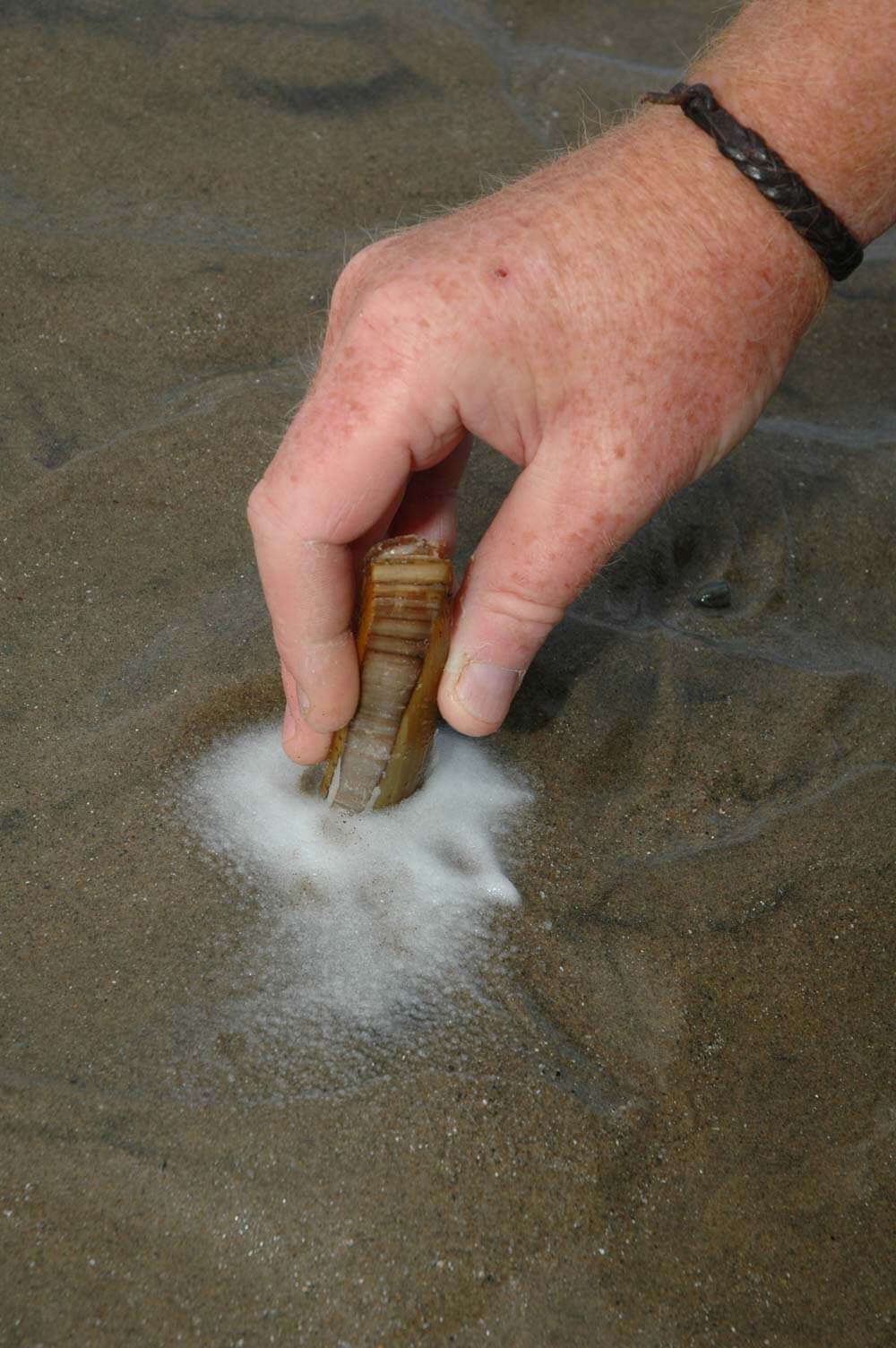
METHOD 2
Harder work, but still an effective way to collect razors is with a thin tined ladies garden fork.
You need to walk steadily backwards and watch for the squirt of water blowing out of the top of the razors burrow as it dives having felt your weight passing overhead.
As the water blows, move forward and place the fork about 6" infront of the blow hole and quickly dig in towards the burrow at a slight angle and you'll lift the razor clear inside the fork of sand. You need to be pretty quick digging like this and you'll still break a few and completely miss some, but a good digger will average 50 plus over the low tide period.
METHOD 3
Little used and even less written about nowadays is the razor spear. This is a small pointed spear made from metal with a barb on. This is only effective on the common razor because of the shell shape, and not on the smaller sword razor.
The idea is that you stand over the hole and push the spear down the line of the burrow until you feel it pass in to the top of the razorfish. Twisting the spear sideways then fixes the barb inside the top of the razorfish which is then pulled upwards through the burrow.
This is fine in theory, but few anglers find this method easy and many of the razors are lost when the spear breaks the shell. This method also relies on the surrounding sand being fairly well drained and tightly packed. If the holes fill in quickly with collapsing wet sand, you'll find it impossible to follow the line of the burrow.
METHOD 4
Possibly the easiest of all is to watch the weather forecast. Look for a really strong gale that blows for at least a couple of days simultaneously with the lowest spring tides.
The knack is to get down on to the beach about mid way through the ebb tide. If a big surf has done it's job, there should be live razorfish washing up along the ebbing tide line and this will continue right down to the low water line. But you need to be quick, for the local seagull population also know this trick and quickly clean up the live razors.
This type of collecting is best when the ebb tide falls in darkness and seagull activity is minimal. You'll still do well in daylight though, if you're quick.
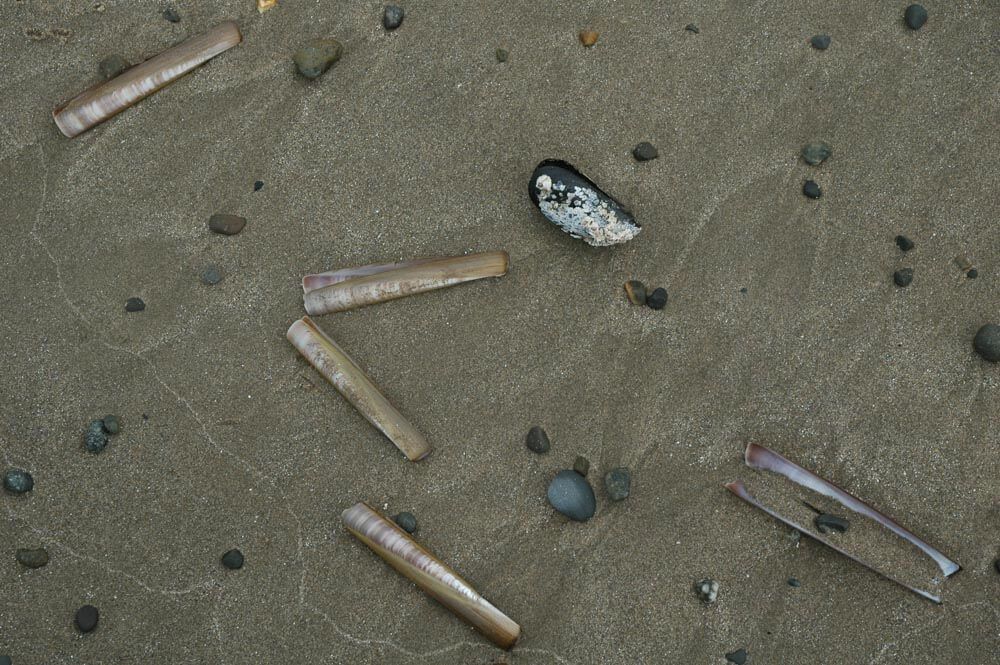
STORAGE
Razorfish for use within a couple of days keep quite happily in a bucket of fresh seawater, and much longer if you continually freshen the water each day.
When travelling, place them in plastic ice cream tubs with ice blocks above them in a cool box. They' ll live at least a couple of days like this.
If you want to freeze razorfish, make sure that they are fresh from the sand and live leaving them inside their shells. Place them individually on flat metal trays that have been pre cooled in the freezer and wait until they re fully frozen. This usually takes about 4 hours, depending on the size of the razors. Now pack them in to plastic sealable bags in half dozens and expel all the air. This gets you the best results when home freezing.
PRESENTATION
You can use razorfish whole, or in chunks mounted on to the hook by sliding the razor over the point and along the shank, then whipping over it with shearing elastic. With whole razors it' s best to position the more solid foot near the point of the hook to add further strength.
You can get away without the thread for short casting, but the razorfish, even when fresh and live is still a softish bait and small nuisance fish can easily rip the bait of the hook and render it useless very quickly.
Razorfish is an excellent tipping bait for use with worm. Try a sliver as a tippet when chasing dabs and flounders, or mount a whole razorfish down the side, splint fashion, on a large lug bait for cod. This is especially effective in the early new year period when many razorfish are washed out by the gales.
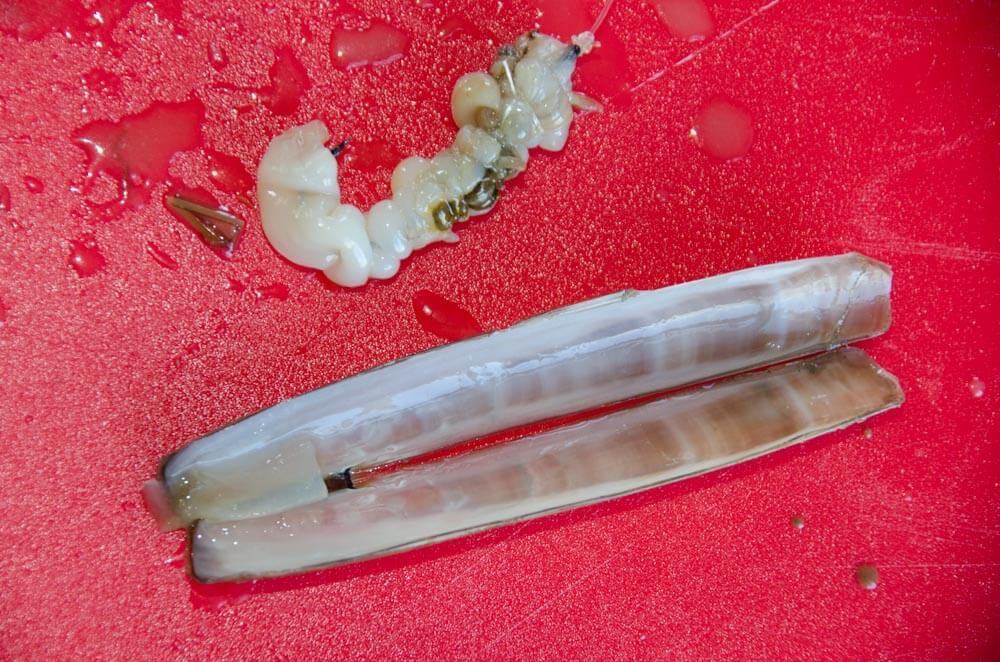
POTENTIAL SPECIES
Razorfish is especially good for flounder in the new year used whole, or in halves. Small chunks or strips takes flounders, dabs, whiting, dogfish and rockling. Bigger halves or whole baits attract codling and cod, bass, and occasionally shore turbot.
TIPS
Whilst razorfish can be collected during daylight hours, the best collecting is during darkness when the shellfish comes close to the surface sand, and may even have the end of the shell sticking out clear of the sand.
You' ll find the heavier concentrations of the smaller sword razors closer to freshwater streams and estuary mouths that wash over the beach, but the bigger common razors will be on the opposite side of the beach furthest away from freshwater influence.
RAZORFISH FACTS
Razorfish burrow by first stretching downwards with and then expanding the foot at the base of the shellfish which acts as an anchor point, then the body and shell is drawn after it. The foot then retracts to stretch downwards again and the process starts over.
Razorfish make good eating and are found on the menu in French restaurants and they' re also used in some Chinese dishes.
Such is the popularity of razorfish with the Chinese that in the UK, proprietors of Chinese restaurants have decimated many razorfish beds by over collection. This has happened especially in southwest and west Wales, and also along some of the Cornish beaches.
In very cold winters such as 1963 and the early 80' s huge numbers of razorfish died of hypothermia and were washed ashore when the savage frosts quickly froze the sand over low spring tides.
The common or pod razorfish is the larger of the two growing up to at least 12" long and has a straight shaped shell.
The smaller sword razorfish is named after the curved cutlasses used by pirates, it's shell turning inwards slightly at each end. It grows to about 6" long.

HABITAT
Lives along the mean low water line of big spring tides on clean sandy surf beaches. Colonizes sandy gutters in small concentrations, or in vast beds spread along the flat sands. Divers report that large razor beds can extend far out to sea and in water depths up to at least 100.
Prefers areas of tightly packed sand which is easier to form a permanent burrow in than loose, coarse grained sand that is continually moving.
Can be found to a lesser degree inside estuary mouths, again on sand banks and sometimes in a mud/sand mix just to the edge of the main estuary channels where the tide run is lessened.

SEASON
Being sand burrowers and making a permanent home on the beach razors are collectable over the full 12 months of the year.
TIDES
These are critical for collecting razorfish. Only on the very biggest spring tides of the monthly cycle will large expanses of the razor beds be uncovered and provide maximum collection time.
On the smaller sized spring tides only the very fringe of the beds is exposed, giving only a limited time to collect the razors.
Ideal tides to pick are the springs that fall during a period of high pressure when the predicted low tide level can be exceeded and the tide travels further out than expected.
During periods of unsettled seas with a long surf wash running up and then backwards down the beach, often the tide does not go out as far as predicted making collection difficult.
WEATHER
Razorfish are not tolerant of cold weather, so avoid trying to collect razors during frosty weather, especially if the sand where the razors live will be exposed whilst frost is forming. This pushes them much deeper into their burrows.
Razors will also be deep during rough seas. They are prone to being washed completely out of their holes through sand displacement, so burrow deeper just prior to storms which they predict by feeling the change in barometric pressure.
NO HEAVY FOOTFALLS
Razorfish are hunted by birds, so they've developed a warning system that detects pressure displaced by weight on the sands surface. If they feel sudden increases in pressure over the surrounding sand near to their burrow, they eject water through their syphon and dive deep like a submarine.
Whichever form of collection method you decide to use, the secret to success is to tread lightly and carefully, or the razorfish will be long gone and too deep to extract.
SPOTTING RAZORFISH
This is easy. Razors leave a tell tale key hole shaped opening at the top of their burrow. Sometimes though, this can fill in slightly if the sand is wet and looks more like a shallow dish in the sand.
The other way is to walk backwards along the sand, and as your weight is detected by the razor as you walk over it's hole, you'll see the water spout they eject as they burrow to escape.
COLLECTION
METHOD 1
The simplest way to collect a bucket of razorfish is by using saltwater. Clean out a washing up liquid bottle and fill it with seawater that's got 4 heaped desert spoons of rock salt added to it.
Search the sand looking for the open key hole depression, but treading lightly, then squirt a liberal amount of the salt solution down in to the hole. Move on and locate a few more holes within a small radius of the first pouring the salt water down in to each.
What happens now is that the razors either think the tide has come in and rise in their burrows to feed through their siphons, or they dislike the heavy concentration of salt and rise to try to clear it. Whichever, it makes them poke the tops of their shells above the sand, and providing you use light footsteps, you can approach the razor, but there is a special technique required to actually remove them whole from the burrow.
Grab the razor by the top of the shell, but don't try to yank it out, or you'll end up with an empty shell and the poor razorfish is left naked deep down inside the burrow where it will die. Keep a steady but gentle upward pressure and you'll feel the razor give a little then hold, give some more and hold, but eventually it will come clear and intact.

METHOD 2
Harder work, but still an effective way to collect razors is with a thin tined ladies garden fork.
You need to walk steadily backwards and watch for the squirt of water blowing out of the top of the razors burrow as it dives having felt your weight passing overhead.
As the water blows, move forward and place the fork about 6" infront of the blow hole and quickly dig in towards the burrow at a slight angle and you'll lift the razor clear inside the fork of sand. You need to be pretty quick digging like this and you'll still break a few and completely miss some, but a good digger will average 50 plus over the low tide period.
METHOD 3
Little used and even less written about nowadays is the razor spear. This is a small pointed spear made from metal with a barb on. This is only effective on the common razor because of the shell shape, and not on the smaller sword razor.
The idea is that you stand over the hole and push the spear down the line of the burrow until you feel it pass in to the top of the razorfish. Twisting the spear sideways then fixes the barb inside the top of the razorfish which is then pulled upwards through the burrow.
This is fine in theory, but few anglers find this method easy and many of the razors are lost when the spear breaks the shell. This method also relies on the surrounding sand being fairly well drained and tightly packed. If the holes fill in quickly with collapsing wet sand, you'll find it impossible to follow the line of the burrow.
METHOD 4
Possibly the easiest of all is to watch the weather forecast. Look for a really strong gale that blows for at least a couple of days simultaneously with the lowest spring tides.
The knack is to get down on to the beach about mid way through the ebb tide. If a big surf has done it's job, there should be live razorfish washing up along the ebbing tide line and this will continue right down to the low water line. But you need to be quick, for the local seagull population also know this trick and quickly clean up the live razors.
This type of collecting is best when the ebb tide falls in darkness and seagull activity is minimal. You'll still do well in daylight though, if you're quick.

STORAGE
Razorfish for use within a couple of days keep quite happily in a bucket of fresh seawater, and much longer if you continually freshen the water each day.
When travelling, place them in plastic ice cream tubs with ice blocks above them in a cool box. They' ll live at least a couple of days like this.
If you want to freeze razorfish, make sure that they are fresh from the sand and live leaving them inside their shells. Place them individually on flat metal trays that have been pre cooled in the freezer and wait until they re fully frozen. This usually takes about 4 hours, depending on the size of the razors. Now pack them in to plastic sealable bags in half dozens and expel all the air. This gets you the best results when home freezing.
PRESENTATION
You can use razorfish whole, or in chunks mounted on to the hook by sliding the razor over the point and along the shank, then whipping over it with shearing elastic. With whole razors it' s best to position the more solid foot near the point of the hook to add further strength.
You can get away without the thread for short casting, but the razorfish, even when fresh and live is still a softish bait and small nuisance fish can easily rip the bait of the hook and render it useless very quickly.
Razorfish is an excellent tipping bait for use with worm. Try a sliver as a tippet when chasing dabs and flounders, or mount a whole razorfish down the side, splint fashion, on a large lug bait for cod. This is especially effective in the early new year period when many razorfish are washed out by the gales.

POTENTIAL SPECIES
Razorfish is especially good for flounder in the new year used whole, or in halves. Small chunks or strips takes flounders, dabs, whiting, dogfish and rockling. Bigger halves or whole baits attract codling and cod, bass, and occasionally shore turbot.
TIPS
Whilst razorfish can be collected during daylight hours, the best collecting is during darkness when the shellfish comes close to the surface sand, and may even have the end of the shell sticking out clear of the sand.
You' ll find the heavier concentrations of the smaller sword razors closer to freshwater streams and estuary mouths that wash over the beach, but the bigger common razors will be on the opposite side of the beach furthest away from freshwater influence.
RAZORFISH FACTS
Razorfish burrow by first stretching downwards with and then expanding the foot at the base of the shellfish which acts as an anchor point, then the body and shell is drawn after it. The foot then retracts to stretch downwards again and the process starts over.
Razorfish make good eating and are found on the menu in French restaurants and they' re also used in some Chinese dishes.
Such is the popularity of razorfish with the Chinese that in the UK, proprietors of Chinese restaurants have decimated many razorfish beds by over collection. This has happened especially in southwest and west Wales, and also along some of the Cornish beaches.
In very cold winters such as 1963 and the early 80' s huge numbers of razorfish died of hypothermia and were washed ashore when the savage frosts quickly froze the sand over low spring tides.

